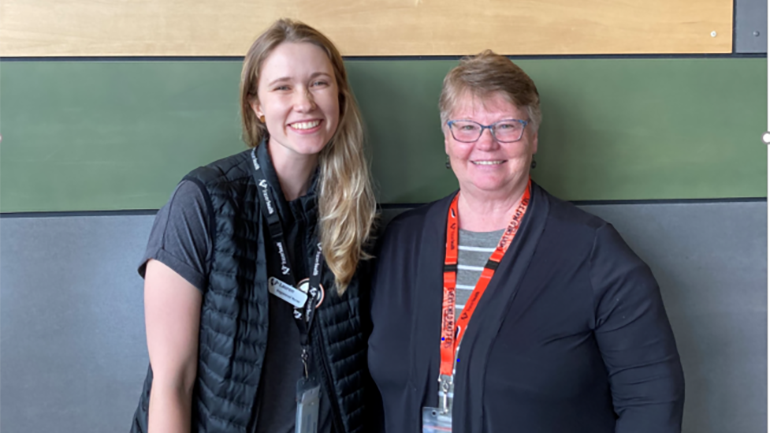
People using substances at home alone are at highest risk for toxic drug death and the most difficult to reach. A dedicated team of nurses, outreach workers and peer support workers are working to change that.
Photo (from left to right): Lauren Johannesen and Leslie Billinton
BC Coroners Report statistics showed that nearly 68 per cent of overdose deaths in our region in 2022 occurred in private residences.
This trend continues.
Many of the people dying are using alone. Stigma often prevents people from reaching out for support.
Fraser Health’s Overdose Outreach Team (OOT) has been working hard to change that. And their team-based, trauma-informed partnership approach to care is working to reach what is commonly called the “hidden population” of substance users.
Registered Nurse with the OOT team, Lauren Johannesen, outlines one of the important avenues they use to reach people using at home alone:
“We have important connections with B.C. Emergency Health Services (BCEHS) and Surrey Fire Service. When BCEHS has attended a toxic drug poisoning event and the person is not transported to hospital, they’re offered a substance use referral that often comes to the OOT team.
We then utilize the second responder program, with Surrey Fire Services for example, in which a firefighter, an overdose outreach team nurse and a peer support worker return to the home of the person who has experienced a toxic drug event. If the person consents, the firefighter introduces us and the nurse starts a conversation to create connection and provide education and resources. Family members are often present, so we educate the family and provide resources and training for Naloxone administration.
The most important moment of this interaction though, is when the accompanying peer support worker says, ‘I’ve been where you’ve been.’ All of a sudden, we’re not the intimidating people wearing Fraser Health lanyards. We’re here to walk alongside them.
As a team, we’re looking to break down stigma in communities and help people build networks of support,” Lauren says.
The team recognizes that people use drugs for a variety of reasons and in a variety of ways. Not everyone who uses has a substance use disorder and this is an important distinction. But right now, everyone who uses is at risk because of how unregulated and toxic the current drug supply is.
Both Lauren, and her colleague, Registered Nurse Leslie Billinton, say one of their main priorities is to create conditions that support wellness and reduce the risk of overdose, which may mean navigating the toxic drug supply or separating from it.
“We are a collaborative team of peer support workers, outreach workers and nurses. Using trauma and resiliency informed practices and harm reduction approaches really allows us to think outside the box. We brainstorm together to reach the people who are difficult to reach and to provide client-centred care for every person we engage with,” Leslie says.
We are highlighting and celebrating stories of nurses who provide exceptional, person-centred and compassionate care in celebration of National Nurses Week. Read other stories here.
Interested in a nursing career with Fraser Health? Visit our Careers page.
